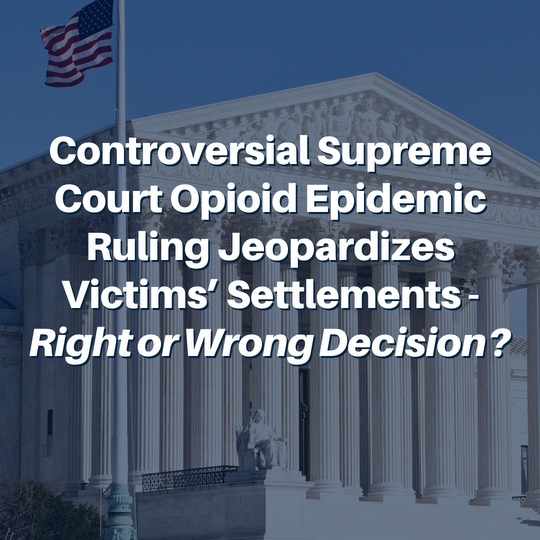
In a landmark 5 to 4 Decision, the United States Supreme Court in the case of Harrington v. Purdue Pharma ruled that allowing the release of the Sackler family as part of the Purdue Bankruptcy was impermissible under the Bankruptcy Code.
This controversial decision invalidates a negotiated global settlement of the thousands of claims of victims of opioid injuries and deaths alleged to have resulted from the misdeeds of the Sackler family and their company, Purdue Pharma, in the marketing and sale of the popular opioid painkiller OxyContin.
Did the Supreme Court make the right or wrong call?
What will happen with the claims now?
What were the claims Against Purdue and the Sacklers?
Purdue Pharma was a drug company owned and operated by the Sackler family. In the 1990s, Purdue developed the drug OxyContin, a powerful and addictive opioid painkiller. Purdue and individual members of the Sackler family who ran the company aggressively marketed Oxycontin and downplayed its addictive qualities.
OxyContin became wildly popular and played a central role in the opioid abuse crisis from which millions Americans and their families suffered or died. In 2007, Purdue pled guilty to criminal charges misbranding of OxyContin. Thousands of civil suits followed both by individual victims and their families and by governments alleging harm from the opioid crisis.
It is estimated that the total value of the opioid crisis is $40 trillion, which is seven times the annual spending of the United States government.
What did Purdue and the Sacklers do to try to Escape from the Claims?
Realizing that the Opioid litigation would eventually lead to their personal financial ruin, the Sackler family began a “milking“ program in which they took a large percentage of Purdue’s revenue out of the company each year and deposited it into overseas accounts and trusts to protect it from the victims and other creditors. It is estimated that the Sacklers milked a total of $11 billion from Purdue.
This milking program eventually drove Purdue Pharma (but not the Sacklers) into Bankruptcy because litigation was mounting and it became clear that Purdue’s assets were worth far less then the value of the victims’ claims.
How is Bankruptcy Supposed to Work?
Bankruptcy exists in order to allow individuals or companies who are insolvent (debts exceed assets) to receive a discharge of their debts if they offer a “full and fair surrender” of all of their assets.
A Bankruptcy Trustee is appointed to manage the process and the Debtor and its Creditors work out a proposed Plan to be approved by the Trustee and the Court. Once the Plan is approved, the assets are paid out to the Creditors and the insolvent individual or company is discharged/released from all of its debts.
How Was the Purdue Bankruptcy Unique?
The Purdue bankruptcy was unique because in addition to seeking its own discharge from the opioid claims, Purdue also sought the discharge of the Sackler family so that they would be forever released from any past or future opioid claims. In order to justify such a release, the Sackler family agreed to pay about $5 billion(over a decade) into the Purdue Bankruptcy from the $11 billion it had milked from Purdue.
Ultimately, the a majority of the victims agreed to this settlement proposal and the Sackler release. Under the settlement, individual victims would receive between $3500 and $48,000 each depending on the severity of the harm.
The Trustee agreed to approve the proposed settlement which would provide compensation to thousands of victims and their families as well as governmental entities that had made opioid claims and, in exchange, both Purdue and the entire Sackler family would be released from any past or future opioid claims.
Why did the Supreme Court Strike Down the Bankruptcy Plan?
In a close vote of 5 to 4, the Supreme Court Majority ruled that the proposed settlement and discharge of the Sacklers was not allowed under the Bankruptcy Act.
In the end, the reasoning was fairly simple. The Majority held that the Bankruptcy Act does not permit the release of a person or entity other than the Debtor who filed for Bankruptcy without the consent of the Creditor.
In this case, Purdue Pharma filed for Bankruptcy, not the Sacklers. However, the settlement agreement provided for a complete release of Purdue and the Sacklers. Moreover, although the Sacklers had agreed to return monies to the Purdue Bankruptcy to help fund the victims’ settlements, they were only returning a fraction of their assets, about $5 billion of the $11 billion it had milked from Purdue.
Ultimately, the Majority ruled that this non-debtor release was not permitted under the Bankruptcy Act.
What Happens to the Victims Now?
The Opinion of the Justices who dissented to this decision is critical of the basic reasoning of the Majority and laments that this decision will be devastating to the victims of the opioid epidemic.
The dissenting Justices argued that a vast majority of the victims had agreed to the proposed settlement and that the Court striking it down jeopardizes any chance at recovery because the Sacklers have shielded themselves by moving their money overseas and placing it in trusts.
It is certain that the litigation will move forward against both Purdue and the Sacklers and there will likely be more settlement talks that may or may not result in a global settlement. It remains to be seen whether the victims will do better or worse then what was proposed in the Bankruptcy settlement.
My Thougths
In my opinion, the Supreme Court did the right thing.
Bankruptcy is meant to protect people or companies who relinquish all of their assets to their creditors. It was not designed to release other related people without the creditors’ consent. In this case, the Sacklers tried to piggy back on the Purdue Bankruptcy and be released from all claims without giving up anything close to the entirety of the assets that they had milked from Purdue.
The Sacklers should be held accountable for their wrongful actions and forced to relinquish the vast majority of their assets in the event that they want to be released from liability.
It’s unfortunate that victims must wait and fight for more compensation, but it appears to me that the deal that had been struck was not fair to all concerned.
Tim Rayne is a Pensylvania Personal Injury lawyer with the Chester County law firm MacElree Harvey, Ltd. Tim helps injured accident victims understand their legal rights and receive fair compensation from insurance companies. Contact Tim at 610-840-0124 or trayne@macelree.com or check out his website at www.TimRayneLaw.com.
